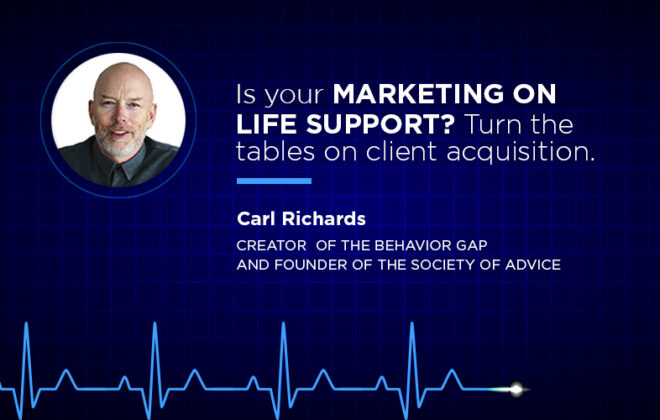Your Path to Advisor Marketing Mojo Starts Here
If you want to grow your advisor practice and don’t want to buy leads (which we generally caution against), you need to figure out the best way to market YOU. There are several variables to consider, like what dollar amount you should allocate to your marketing budget, what tasks you should handle yourself vs. hand off to others, and what marketing mix makes the most sense for you. Let us show you the way!
As an Advisor Development Organization with decades of insight under our belts, we’re always keen on finding out what marketing efforts pay the biggest dividends for our highest performing advisors. If you’re aspiring to greatness, why not learn from the best? In addition, the traits the great ones generally have in common also go hand-in-hand with their marketing endeavors.
Common qualities of highly successful advisors
Our industry has changed dramatically in recent years, and what we’ve learned—and what industry insiders also tell us—is that today’s most successful and highest-performing advisors tend to do much if not all of the following:
• They are niche focused—they don’t try to be everything to everybody.
• They position themselves as problem solvers instead of focusing on selling their services.
• They don’t try to blend in, they try to stand out.
• They lean into their strengths to differentiate themselves (great listening skills, problem solving abilities, sense of humor, gift of gab, familiarity with a particular niche, etc.).
• They identify and invest in a marketing mix that is a good fit for their unique practice and personality.
• They understand the power of a solid digital footprint.
• They use fintech to improve business efficiencies and close more leads.
OK, so that’s a lot, and some advisors are stronger in certain areas than others. So, how do you get started if you need to seriously fine tune your marketing program and set it up for long-term success?
Three key steps to ignite advisor marketing mojo
Step 1: Determine your marketing budget.
We get it, this can be tricky, and the answer to, “How much should I allocate to my advisor marketing budget?” will vary depending on who you ask. Some experts say you should set aside as much as 20% of your annual revenue for marketing, but in reality, it all depends on how established your firm is and what you can afford.
What are other firms actually spending? According to a recent survey published by The Kitces Report, “marketing spend evolves with practice growth.” The survey results were segmented into five different stages of practice revenue, and the median share of annual revenue spent broke down as follows:
• Stage 1 (practice revenue < $250K): 7.1%
• Stage 2 (practice revenue $250K-$499K): 6.5%
• Stage 3 (practice revenue $500K-$749K): 4.5%
• Stage 4 (practice revenue $750K-$1.49M): 8.4%
• Stage 5 (practice revenue $1.5M or more): 8.8%
It’s important to note that these percentages include both hard dollars (the items for which you shell out cash, like a website) and soft dollars (the costs associated with your and your team’s time). According to the Kitces survey, about 31% of marketing costs are associated with hard dollars, while 69% are associated with soft dollars.
Based on these numbers the median amount that practices producing $250K in revenue spend on marketing amounts to $17,750, with $5,503 going to those hard dollar marketing expenses.
What does this mean for you and your marketing budget? It depends. if you’re just launching your advisor practice you will need to spend more upfront to get your marketing program off the ground. This includes a website, CRM system, SEO integration and more. A new website typically runs anywhere from $3,000 and up, and it’s critical to a 21st century advisor’s success. Other costs to consider include:
• Your and your team’s time (this is the biggie).
• Website monthly management, SEO and support fees.
• Marketing automation and other fintech tools.
• Paid search fees (Google ads, social media ads, etc.).
• Outsourced marketing services (social media management, email distribution, graphics, content and video production, etc.).
• Internal marketing support team.
• Advisor directory listings.
• In-person activity expenses (webinars, seminars, networking, speaking engagements, etc.).
Building a robust digital footprint is also key for attracting clients, especially Millennials. Learn more about the process and why it’s so important in our recent post on marketing to Millennials.
Step 2: Test the waters to pin down a marketing mix that works for you.
Let’s start with another important nugget the Kitces survey revealed, search engine optimization (SEO)—which requires a minimal time investment on the advisor’s part—is the tactic that has the highest marketing efficiency for financial advisors and the lowest aggregate client acquisition cost ($1,271), followed by referrals and drip marketing. We can’t stress strongly enough how important SEO is to an advisor’s practice today, especially when you also have solid lead conversion tools built into your website.
Referrals are awesome, when you can get them, but most advisors can’t (and don’t) rely on referrals to grow their businesses, especially early on. Which brings us to email marketing, which delivers some of the highest ROI for the marketing dollar (an average of $38 for every dollar spent, according to the Direct Marketing Association). It’s also easily automated and very efficient (as noted above) but it does take time to build and nurture a good email list.
Paid search (ads on Google, Facebook, LinkedIn, etc.) is another marketing tactic some advisors find beneficial, especially when they’re trying to get their business off the ground. It’s a great way to fortify a contact list to market to for those highly efficient email drip campaigns. Many advisors also take advantage of advisor directory listings (26% according to Kitces), which may be complimentary for those paying an organization’s membership or certification fees (e.g., CFP Board, NAPFA, XYPN and FPA).
Other marketing tactics are more time consuming for advisors (creating content, blogging, podcasting, social media management, securing speaking engagements, etc.), so you’ll need to determine whether to hire an internal team member or outsource certain marketing tasks (more on outsourcing below), so you can spend more of your valuable time serving clients.
Finally, advisors often use in-person events, like seminars, client appreciation events, networking, community events and speaking engagements to build their reputation and get leads, as well as webinars. Which approach feels more comfortable for you, and which yields the best results?
Step 3: Decide which marketing tasks to outsource.
As noted above, about 69% of an advisor’s marketing budget typically goes to soft costs related to the advisor and their team’s time. Outsourcing a portion of your marketing tasks to an outside firm can be very cost-effective.
There are a variety resources to consider when weighing vendor options, including marketing companies, SEO specialists, fintech companies, content marketing firms and ad agencies, just to name a few. You just need to decide which tasks are bogging you down and find a firm that is a good fit for your needs.
For example, advisors who invest in InsurMark’s award-winning digital marketing platform Catalyst are able to automate numerous marketing tasks (personalized emails, lead generation, prospect engagement through emails, social media posts, landing pages and a search engine-optimized website). However, there may be other time-consuming tasks an outside vendor could handle, like producing and distributing blogging content, videos, podcasts, and so on.
How do you determine which vendors will be a good fit for you? According to Diana Cabrices, a Fractional Chief Evangelist for B2B WealthTech Brands, advisors can start by asking themselves whether they have enough distribution avenues today to invest all of their marketing dollars in one basket.
Says Cabrices, “Usually the answer is no, you probably need a combination of tools to help you be successful. Maybe it’s fundamentals, SEO, blogging, email marketing and nurturing your list after you grow that distribution. Maybe it’s putting you on stage at a seminar in front of a whole new crowd of people you never connected with before. There are different ways to expand that distribution, and vendors all have their own specialty.”
Cabrices also says that advisors need to ask the “right” questions when interviewing vendors. Along with asking about costs, how the engagement will be handled and what input is expected from the advisor’s team, Cabrices encourages advisors to clarify what distribution channels will be pursued and how:
• Is this going to open up new distribution and connections for me or work off of existing contacts, emails lists and social media followers?
• What other distribution channels will be involved, like speaking engagements, seminars, podcasts, etc.?
• Will I be relying on you to distribute my content or have to do it myself (i.e., post social media content and blogs, send emails, distribute video clips, etc.)?
If you want to expand your reach and get more new leads, which most advisors do, it’s important to find out how the vendors will help you accomplish that goal. Are you struggling to nurture and close existing leads? Then you’ll want to find out what impact the vendor’s tools have on improving an advisor’s closing ratio.
To get more marketing mojo insight from Diana Cabrices and InsurMark Virtual CMO Jack Martin, check out our recent episode of The Breakthrough Advisor Podcast, Harnessing Fintech Innovation for 2024 Marketing Success.
We help advisors get more bang for their marketing buck
From Catalyst, our award-winning digital marketing platform that advisors say attributes a staggering 30.9% to their revenue growth to MyWebsite, our SEO friendly website solution, InsurMark has your advisor marketing needs covered. And that’s just the beginning!
To learn how our advisor development organization can help you grow your practice, contact our office toll-free at (800) 752-0207 or connect with us online.
As an ADO – Advisor Development Organization™, InsurMark provides solutions to meet the ever-evolving needs of financial professionals with a mission to protect and enhance the financial security of every home in America.
FOR FINANCIAL PROFESSIONAL USE ONLY. NOT TO BE USED FOR CONSUMER SOLICITATION PURPOSES.




